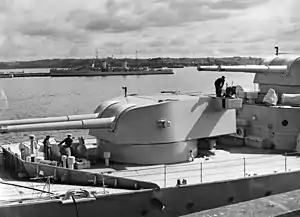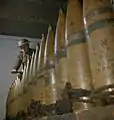| Ordnance BL 8 inch gun Mk VIII | |
|---|---|
 Forward 8-inch turrets aboard HMAS Canberra | |
| Type | Naval gun Coast defence gun |
| Place of origin | United Kingdom |
| Service history | |
| In service | 1927 – 1954[1] |
| Used by | Royal Navy Royal Australian Navy Spanish Navy |
| Wars | Second World War Spanish Civil War |
| Production history | |
| No. built | 168[2] |
| Specifications | |
| Mass | 17.5 tonnes[2] |
| Barrel length | 400 inches/10 meters(50 calibres)[2] |
| Shell | 256 pounds (116 kg) |
| Calibre | 8-inch (203 mm)[2] |
| Muzzle velocity | 2805 feet per second (855 m/s)[2] |
| Maximum firing range | 28 kilometres (17 mi)[2] |
The BL 8 inch gun Mark VIII[note 1] was the main battery gun used on the Royal Navy's County-class cruisers,[note 2] in compliance with the Washington Naval Treaty of 1922. This treaty allowed ships of not more than 10,000 tons standard displacement and with guns no larger than 8 inches (203 mm) to be excluded from total tonnage limitations on a nation's capital ships. The 10,000 ton limit was a major factor in design decisions such as turrets and gun mountings. A similar gun formed the main battery of Spanish Canarias-class cruisers.[3] In 1930, the Royal Navy adopted the BL 6 inch Mk XXIII naval gun as the standard cruiser main battery in preference to this 8-inch gun.[4]
Description
These guns, 50 calibres long, were built-up guns which consisted of a wire-wound tube encased within a second tube and jacket with a Welin breech block and hydraulic or hand-operated Asbury mechanism. Two cloth bags each containing 15 kg (33 lb) of cordite were used to fire a 116 kg (256 lb) projectile. Mark I turrets allowed gun elevation to 70 degrees to fire high-explosive shells against aircraft. Hydraulic pumps proved incapable of providing sufficient train and elevation speed to follow contemporary aircraft; so simplified version of the Mark II turrets with a maximum elevation of 50 degrees were installed in the 'Exeter. Each gun could fire approximately five rounds per minute. Useful life expectancy was 550 effective full charges (EFC) per barrel.[2]
Naval service
The following ships mounted Mk VIII guns in 188-tonne twin turrets.[2] The standard main battery was four turrets, but Exeter and York carried only three to reduce weight and formed the separate York class.[5]
- County-class heavy cruisers : 13 ships
- Canarias-class heavy cruisers : 2 ships
- York-class heavy cruisers : 2 ships
Coast defence guns

Six single guns capable of elevating to 70 degrees were installed as coastal artillery in the Folkestone-Dover area during the Second World War.[2]
Ammunition
 World War II semi-armour-piercing shell with marker dye to identify ship that fired it for range corrections
World War II semi-armour-piercing shell with marker dye to identify ship that fired it for range corrections 1930s high-explosive shell
1930s high-explosive shell Coast-defence gun shells, World War II
Coast-defence gun shells, World War II
Shell trajectory
Range with 256 lbs. (116.1) SAPC with MV = 2,725 fps (831 mps)
| Range[2] | Elevation | Time of flight | Descent | Impact velocity |
|---|---|---|---|---|
| 5,000 yd (4,570 m) | 2° 11′ | 6 s | 2° 31′ | 2154 ft/s (657 m/s) |
| 10,000 yd (9,140 m) | 5° 14′ | 14 s | 7° 15′ | 1683 ft/s (513 m/s) |
| 15,000 yd (13,720 m) | 9° 47′ | 25 s | 15° 49′ | 1322 ft/s (403 m/s) |
| 20,000 yd (18,290 m) | 16° 34′ | 38 s | 28° 31′ | 1169 ft/s (356 m/s) |
| 25,000 yd (22,860 m) | 26° 44′ | 56 s | 43° 7′ | 1164 ft/s (355 m/s) |
| 29,000 yd (26,520 m) | 41° 28′ | 79 s | 56° 37′ | 1240 ft/s (378 m/s) |
See also
Weapons of comparable role, performance and era
- 203mm/50 Modèle 1924 gun French equivalent
- 20.3 cm SK C/34 Naval gun German equivalent
- 203 mm /53 Italian naval gun Italian equivalent
- 20 cm/50 3rd Year Type naval gun Japanese equivalent
- 8"/55 caliber gun US equivalent
Surviving examples
- A gun from HMAS Australia outside the Australian War Memorial, Canberra
Notes
- ↑ Mark VIII = Mark 8. Britain used Roman numerals to denote Marks (models) of ordnance until after World War II. Hence this was the eighth model of BL 8-inch naval gun.
- ↑ A more accurate term is "Treaty Cruiser", as the term heavy cruiser was only formally defined at the time of the London Naval Treaty of 1930. However, all the 8-inch gun cruisers introduced as a result of the 1922 Washington Treaty were what became known as "heavy cruisers".
References
Bibliography
External links
- Tony DiGiulian, Britain 8"/50 (20.3 cm) Mark VIII
- Terry Gander, Twentieth century British coast defence guns